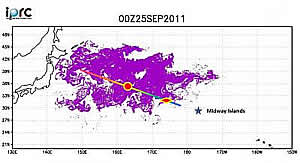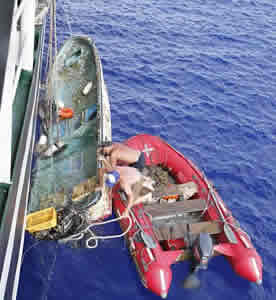
This is a map of Pallada’s route through model-projected debris field as of September 25. Credit: Nikolai Maximenko and Jan Hafne

Hoisting up to Pallada the Japanese boat registered to Fukushima Prefecture, washed into the ocean during the March 11 tsunami. Credit: STS Pallada
Ever since the great Japan tsunami on March 11 washed millions of tons of debris into the Pacific, scientists at the International Pacific Research Center, University of Hawaii at Manoa, have been trying to track the trajectory of this debris that can threaten small ships and coastlines. For nearly half a year, Senior Researcher Nikolai Maximenko and Computer Scientific Programmer Jan Hafner had only their state-of-the-art â€" but still untested â€" computer model of currents to speculate where the debris might end up. Now valuable sightings of the debris are reported from places where the model predicted.
Warned by maps of the scientists' model, the Russian sail training ship, the STS Pallada, found an array of unmistakable tsunami debris on its homeward voyage from Honolulu to Vladivostok.
Soon after passing Midway Islands (see map), Pallada spotted surprising number of floating items. "Yesterday, i.e. on September 22, in position 31042,21 N and 174045,21 E, we picked up on board the Japanese fishing boat. , we've measured it with the Geiger counter," writes Natalia Borodina, Information and Education Mate of the Pallada. "At the approaches to the mentioned position (maybe 10 â€" 15 minutes before) we also sighted a TV set, fridge and a couple of other home appliances."
Later, on September 27: "We keep sighting every day things like wooden boards, plastic bottles, buoys from fishing nets (small and big ones), an object resembling wash basin, drums, boots, other wastes. All these objects are floating by the ship."
The map shows the stretch of Pallada's route where debris was sighted between September 21 and 28, 2011. The red rhombus marks the location where the Japanese boat was found, and the red circle denotes maximum debris density experienced. Purple color shows the distribution of the tsunami debris in the SCUD model on September 25.
On October 8, the Pallada entered the port of Vladivostok, and Borodina was able to send pictures. The most remarkable one is of a small fishing vessel about 20 feet long, which they were able to hoist up on to the Pallada. The markings on the wheel house of the boat show its home port to be in the Fukushima Prefecture, the area hardest hit by the tsunami.
With the exact locations of some of the by now widely scattered debris, the scientists can make more accurate projections about when the debris might arrive at the Papahanaumokuakea Marine National Monument. The first landfall on Midway Islands is anticipated this winter. What misses Midway will continue towards the main Hawaiian Islands and the North American West Coast.
